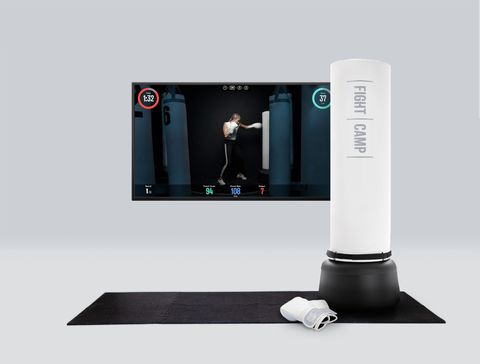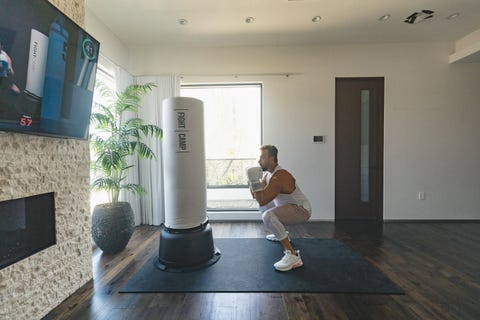When the Covid-19 pandemic struck, I found myself without a place to throw a punch. My gym was just one of many to shut down, and martial arts practitioners, boxing buffs, and casual cardio kickboxers alike lost access to the spaces in which they once sweated, kicked, and punched their way to better health.
To find a new way to channel my aggression during the era of social distancing, I needed a solution I could use in my small apartment (or my tiny Brooklyn backyard, at least). I was slow to join any Zoom-based martial arts sessions; I had a hard time finding motivation to take the same classes I had once joined in person, and awkward technical issues dissuaded me even more. Eventually, I was stuck just jumping rope and shadow boxing by myself.
Enter FightCamp. The connected fitness platform, which is one of many studio class-style offerings on the market from companies eager to capture the captive home workout audience, gave me an opportunity to jump right back into my fight practice with challenging sessions, engaging trainers, and premium equipment. The package isn’t cheap—but once I was able to flow through combinations and pepper the heavy bag with punches and kicks, I felt like I was finally back in the ring.

What Comes in the FightCamp Package
To test out FightCamp, I demoed the company’s ‘Personal’ package, which includes a stand-up heavy bag, floor mat, wraps, gloves, and trackers. The heavy bag is hands down the best freestanding punching bag I’ve used, and the bag ring it sits on (a small circular mat with plastic rails connected by heavy-duty velcro) helps to ensure that it doesn’t slide all over the place once the strikes begin to fly, an issue I’ve had with other bags. That solid base is even more important when you’re working through the rounds in your living room and you can’t afford to do any damage to your furniture.

The brains of the platform are actually in the smallest piece of gear included in the set, the tiny tracking devices. Users slot the trackers into the provided hand wraps worn under the gloves, and the gadgets log every punch you throw during a workout via the connected app. (You can also spring for a set that adds extra wraps and gloves, or a barebones option that includes only wraps, trackers, and membership to the platform.)
The trackers provide an experience that’s less like Peloton and more akin to Apple Fitness+. The streaming classes aren’t live and interactive, but there is a leaderboard which you can view to see how you stack up to other people who have also taken the class. You can also select to compete against specific users, or even your own past performance, so there are opportunities to make the workouts even more engaging and collaborative. This is judged by “Output,” a formula the company developed using “a proprietary algorithm to combine intensity, speed and technique”. I’m not sure exactly how that would stack up in an actual ring for a sparring session against a real opponent, but it provides a fun measuring stick to motivate the most competitive users. You can select in-app radio stations broken down by genre to set the mood for your classes, or connect to your own playlist via Spotify, Apple Music, or Pandora.
Taking Classes with FightCamp
The classes are a highlight. I went into the trial thinking that I would be bored and frustrated with the level of instruction as an experienced boxing and kickboxing practitioner— that has happened to me in the rare times pre-Covid-19 that I took cardio boxing classes for work events—but instead, I found myself challenged by the instructors. The basic techniques for punches and kicks were taught in an accessible, responsible manner, which is more than I can say for some coaches I’ve worked with IRL. Some routines feature pushups and ab moves mixed in with the punch combos, giving non-fighters an extra fitness component. As I made my way through progressively more complicated kickboxing combos with coach Aaron Swensen, I missed the hands-on instruction I had in my in-person Muay Thai classes—but I was able to learn from the careful direction he provided when explaining all the movements.
https://www.instagram.com/p/CGdfiCNhTJS/
A post shared by Brett Williams (@bdwilliams910)
You don’t have to be a hardcore fighter to appreciate FightCamp’s offerings. The library of content is considerably large, and the feature that allows you to compete against your previous performance makes the replay value high. Along with standalone sessions—including a whole series of workouts that use the bag as a base for ab exercises—there are multiple “Paths” you can follow to level up your skills. These progressive series allow for more than just sweat sessions; you’ll become a more proficient puncher, too.
During the workouts, you can actively watch your punch count grow on the screen. Each workout has a set goal, and passing the threshold before the end of the class becomes a challenging hook to push performance. I found myself peeking at gauge between combos and even speeding up to try to pack in more strikes before the bell.
Is FightCamp Worth a Try?
I loved training with FightCamp, but the platform isn’t without caveats. Space is a big concern. The company says that you only need an 8-foot by 4-foot area for the bag, and that’s technically right—but the bag takes up a lot of real estate in a small room. After a few indoor workouts, I moved the heavy bag into my backyard (no small feat in itself) because it took up way too much room in my tiny apartment. Anyone with limited square footage might think twice.
As of press time, the FightCamp app is only available on iOS. While I can cast the workouts to my AppleTV using AirPlay (the company does offer a guide to casting to your TV), it might be difficult for users who don’t have more hardware to engage with the platform on a big screen. If you’re not comfortable working off your small iPhone screen, you might not have a good time.

Like other connected home training solutions, FightCamp ain’t cheap. The Personal package I tested costs $1,219 plus $39 per month for the app membership. Just buying in for the most basic package, which gets you the wraps and sensors, is $439 (plus the monthly fee). There are financing options available so you don’t have to pony up the full cost for gear up front (these range between $76 and $95 per month for fixed periods), but for most exercisers, FightCamp won’t be a cost-efficient supplement to gym memberships as the world begins to reopen—it costs nearly as much as a mid-tier quality health club.
But lots of people will be more than content to keep training in their living rooms for the foreseeable future. If you’re one of those people, FightCamp offers you a rare opportunity for a connected gym: high-level practical instruction that complements the addictive programming and flashy tech specs. You’ll sweat, but more importantly, you’ll learn to throw a punch.
Source: Read Full Article
